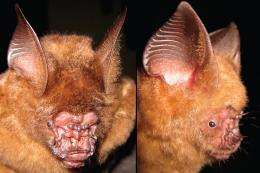Scientists discover new species of roundleaf bat in Vietnam

A team of researchers, supported by the Conservation Leadership Programme (CLP), the Harrison Institute, the University of Tübingen, and the Institute of Ecology and Biological Resources, has discovered a new species of bat in Vietnam.
Named Hipposideros griffini after Donald Griffin (a famous chiropterologist who revolutionised bat research by explaining echolocation), the species was discovered by Thong et al. and described in the Journal of Mammology.
To date, this species has been found in just two locations: Cat Ba Island in northern Vietnam, and Chu Mom Ray National Park on the mainland some 1,000 km to the south. Researchers believe however that its range may extend to other areas in Vietnam as well as China, Lao PDR, Myanmar and Thailand, where similar karst habitats are found.
Hipposideros (or roundleaf bats) are part of a family commonly known as ‘old world leaf-nosed bats’, so-called because of their distinctive leaf-shaped nose ornaments, which help in the transmission of echolocation signals.
Provided by Fauna & Flora International

















